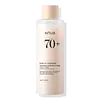What's inside
What's inside
 Key Ingredients
Key Ingredients

 Benefits
Benefits

 Concerns
Concerns

No concerns
 Ingredients Side-by-side
Ingredients Side-by-side

Water
Skin ConditioningOryza Sativa Seed Water
AntimicrobialPropylene Glycol
HumectantGlycerin
HumectantOryza Sativa Extract
AbsorbentSodium Hyaluronate
HumectantCentella Asiatica Leaf Extract
Skin ConditioningPanthenol
Skin ConditioningCaprylic/Capric Triglyceride
MaskingInulin Lauryl Carbamate
Emulsion StabilisingSorbitol
HumectantValine
MaskingProline
Skin ConditioningThreonine
Isoleucine
Skin ConditioningSerine
MaskingHistidine
HumectantPhenylalanine
MaskingSodium PCA
HumectantSodium Lactate
BufferingArginine
MaskingAspartic Acid
MaskingPCA
HumectantTrideceth-6
EmulsifyingGlycine
BufferingAlanine
MaskingCitric Acid
BufferingSodium Benzoate
MaskingSodium Polyacrylate
AbsorbentHydrogenated Polydecene
EmollientPotassium Sorbate
PreservativeWater, Oryza Sativa Seed Water, Propylene Glycol, Glycerin, Oryza Sativa Extract, Sodium Hyaluronate, Centella Asiatica Leaf Extract, Panthenol, Caprylic/Capric Triglyceride, Inulin Lauryl Carbamate, Sorbitol, Valine, Proline, Threonine, Isoleucine, Serine, Histidine, Phenylalanine, Sodium PCA, Sodium Lactate, Arginine, Aspartic Acid, PCA, Trideceth-6, Glycine, Alanine, Citric Acid, Sodium Benzoate, Sodium Polyacrylate, Hydrogenated Polydecene, Potassium Sorbate
Oryza Sativa Bran Water 71%
MaskingButylene Glycol
HumectantGlycerin
HumectantDipropylene Glycol
HumectantNiacinamide
SmoothingPropanediol
SolventWater
Skin Conditioning1,2-Hexanediol
Skin ConditioningMethyl Gluceth-20
HumectantPanthenol
Skin ConditioningBetaine
HumectantOryza Sativa Extract
AbsorbentHydroxyacetophenone
AntioxidantDiphenyl Dimethicone
EmollientTriethylhexanoin
MaskingHydrogenated Lecithin
EmulsifyingAdenosine
Skin ConditioningEthylhexylglycerin
Skin ConditioningCarbomer
Emulsion StabilisingTromethamine
BufferingXanthan Gum
EmulsifyingGlyceryl Acrylate/Acrylic Acid Copolymer
HumectantTheobroma Cacao Seed Extract
AntioxidantSodium Hyaluronate
HumectantHydrolyzed Hyaluronic Acid
HumectantHyaluronic Acid
HumectantDextrin
AbsorbentHydrolyzed Rice Protein
Skin ConditioningOryza Sativa Seed Protein
AntioxidantCeramide NP
Skin ConditioningSodium Lauroyl Lactylate
EmulsifyingArbutin
AntioxidantAscorbic Acid
AntioxidantAllantoin
Skin ConditioningCeramide AP
Skin ConditioningPhytosphingosine
Skin ConditioningCholesterol
EmollientCeramide EOP
Skin ConditioningOryza Sativa Bran Water 71%, Butylene Glycol, Glycerin, Dipropylene Glycol, Niacinamide, Propanediol, Water, 1,2-Hexanediol, Methyl Gluceth-20, Panthenol, Betaine, Oryza Sativa Extract, Hydroxyacetophenone, Diphenyl Dimethicone, Triethylhexanoin, Hydrogenated Lecithin, Adenosine, Ethylhexylglycerin, Carbomer, Tromethamine, Xanthan Gum, Glyceryl Acrylate/Acrylic Acid Copolymer, Theobroma Cacao Seed Extract, Sodium Hyaluronate, Hydrolyzed Hyaluronic Acid, Hyaluronic Acid, Dextrin, Hydrolyzed Rice Protein, Oryza Sativa Seed Protein, Ceramide NP, Sodium Lauroyl Lactylate, Arbutin, Ascorbic Acid, Allantoin, Ceramide AP, Phytosphingosine, Cholesterol, Ceramide EOP
 Reviews
Reviews

Ingredients Explained
These ingredients are found in both products.
Ingredients higher up in an ingredient list are typically present in a larger amount.
Glycerin is already naturally found in your skin. It helps moisturize and protect your skin.
A study from 2016 found glycerin to be more effective as a humectant than AHAs and hyaluronic acid.
As a humectant, it helps the skin stay hydrated by pulling moisture to your skin. The low molecular weight of glycerin allows it to pull moisture into the deeper layers of your skin.
Hydrated skin improves your skin barrier; Your skin barrier helps protect against irritants and bacteria.
Glycerin has also been found to have antimicrobial and antiviral properties. Due to these properties, glycerin is often used in wound and burn treatments.
In cosmetics, glycerin is usually derived from plants such as soybean or palm. However, it can also be sourced from animals, such as tallow or animal fat.
This ingredient is organic, colorless, odorless, and non-toxic.
Glycerin is the name for this ingredient in American English. British English uses Glycerol/Glycerine.
Learn more about GlycerinOryza Sativa Extract comes from the rice grain, Oryza sativa. Rice extract has wound healing, antioxidant, anti-inflammatory, and hydrating properties.
Rice grains contain numerous antioxidants which may help with anti-aging, such as vitamin E. Antioxidants help stabilize free-radical molecules. Unstable free-radical molecules may damage your skin cells and accelerate signs of aging.
A study from 2002 found rice to help increase the rate of wound healing. The same study found an improvement of skin barrier function in the patients after taking rice baths.
Numerous in-vitro studies have found rice water to help decrease sun damage by increasing collagen production and inhibiting the process of tyrosinase.
Long story short- tyrosinase is an enzyme that controls melanin production. Our bodies start producing melanin (AKA tanning) when exposed to UV radiation to protect against damage. Rice water is found to partially block this process.
Though more research is needed on rice's ability to help with UV protection, recent studies seem promising.
Wondering why rice is hydrating? The protein in rice have emollient properties. Emollients create a barrier on the skin to trap moisture in, keeping your skin moisturized.
Some rice extract may have mildly-exfoliating properties. These are mainly limited to Oryza Sativa (Rice) Bran and Oryza Sativa (Rice) Germ Powder.
This rice was first cultivated in China over 10,000 years ago. Many cultures throughout Asia have used rice water on skin and hair for centuries.
Learn more about Oryza Sativa ExtractPanthenol is a common ingredient that helps hydrate and soothe the skin. It is found naturally in our skin and hair.
There are two forms of panthenol: D and L.
D-panthenol is also known as dexpanthenol. Most cosmetics use dexpanthenol or a mixture of D and L-panthenol.
Panthenol is famous due to its ability to go deeper into the skin's layers. Using this ingredient has numerous pros (and no cons):
Like hyaluronic acid, panthenol is a humectant. Humectants are able to bind and hold large amounts of water to keep skin hydrated.
This ingredient works well for wound healing. It works by increasing tissue in the wound and helps close open wounds.
Once oxidized, panthenol converts to pantothenic acid. Panthothenic acid is found in all living cells.
This ingredient is also referred to as pro-vitamin B5.
Learn more about PanthenolSodium Hyaluronate is hyaluronic acid's salt form. It is commonly derived from the sodium salt of hyaluronic acid.
Like hyaluronic acid, it is great at holding water and acts as a humectant. This makes it a great skin hydrating ingredient.
Sodium Hyaluronate is naturally occurring in our bodies and is mostly found in eye fluid and joints.
These are some other common types of Hyaluronic Acid:
Learn more about Sodium HyaluronateWater. It's the most common cosmetic ingredient of all. You'll usually see it at the top of ingredient lists, meaning that it makes up the largest part of the product.
So why is it so popular? Water most often acts as a solvent - this means that it helps dissolve other ingredients into the formulation.
You'll also recognize water as that liquid we all need to stay alive. If you see this, drink a glass of water. Stay hydrated!
Learn more about Water